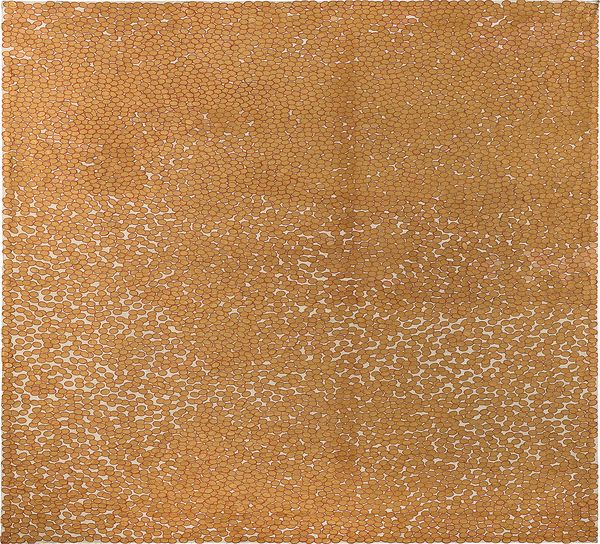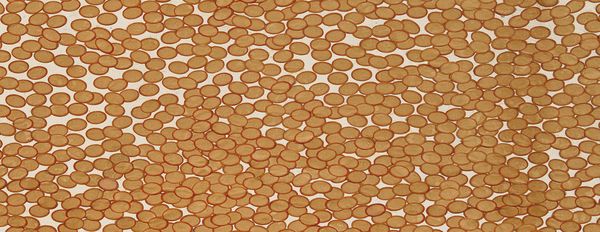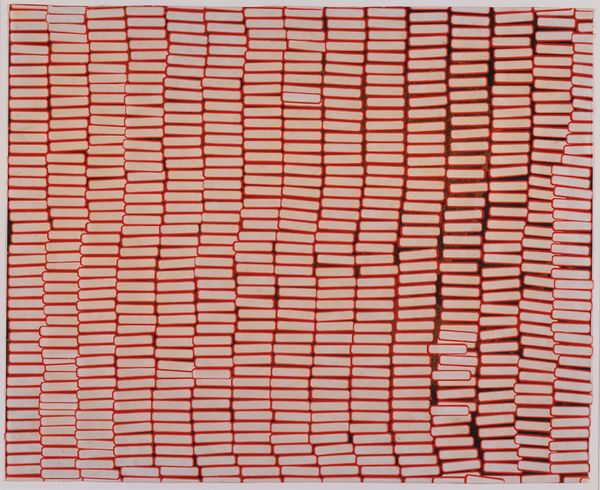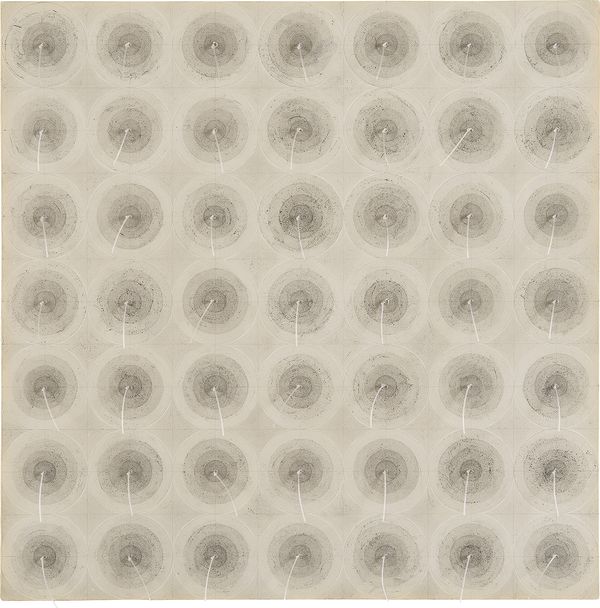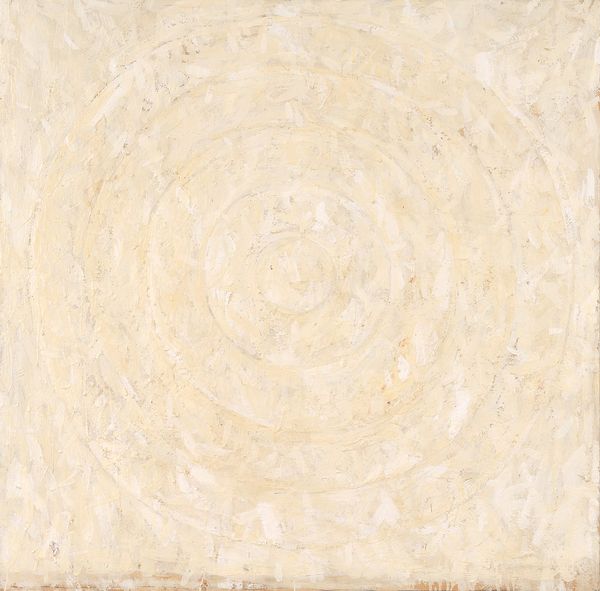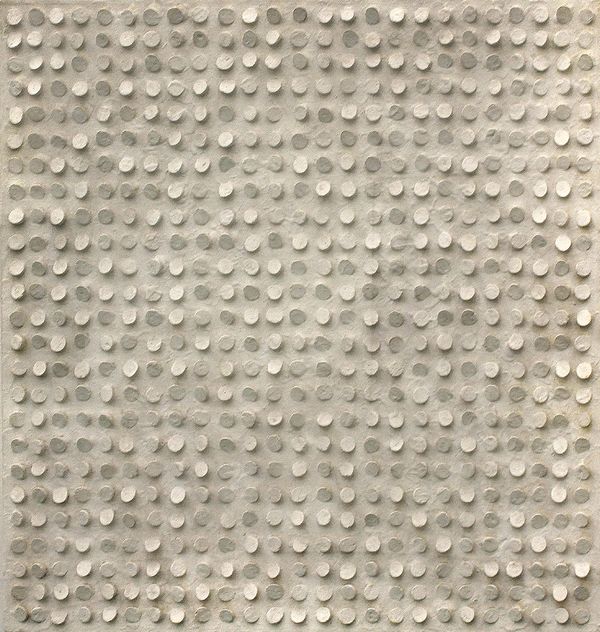Yayoi Kusama Accumulation by Space (No.62.CO.), 1962
Two extraordinary works featured in Phillips’ 20th Century and Contemporary Art Evening Sale this month highlight the aesthetic contributions of Yayoi Kusama and Eva Hesse, two artists who were key to defining new directions of art in the 1960s. The two were friends, and both were indispensable members of the New York art scene during that innovative decade. Exhibiting these works – Kusama’s Accumulation by Space (No.62.CO.), 1962, and Hesse’s No title, 1967 – offers us the opportunity to compare the approaches taken by these important female artists at a foundational point in their careers.
Accumulation by Space (No.62.CO.) and No title exemplify how Kusama and Hesse employed unconventional materials and how each artist pushed the expressive potential of serial abstract forms. Both used repeated forms, though in very different ways. Kusama filled her canvas with irregular masses of red-rimmed oval stickers, creating compelling variations in their grouping and layering. Hesse, on the other hand, defined a grid of nested circles with subtle washes of ink and graphite, punctuating each with nylon strings in its center. These works also suggest psychological states, perhaps communicating the states of mind of their creators. Indeed, both are key examples of what Lucy Lippard defined in 1966 as “Eccentric Abstraction” – artworks which, as the critic noted, “refuse to eschew imagination and the extension of sensuous experience while they also refuse to sacrifice the solid formal basis demanded of the best in current non-objective art.”
Detail from Yayoi Kusama's Accumulation by Space (No.62.CO.), 1962
Created during her first decade in New York, Yayoi Kusama’s Accumulation by Space (No.62.CO.) is one of the artist’s earliest investigations of three pillars that define her practice: repetition, accumulation and obliteration. After leaving Tokyo for the U.S. in 1957, the artist quickly gained critical acclaim. Following the success of her first solo exhibitions, Kusama began to explore mediums other than painting in the early 1960s. The present work is a unique example of her rare collages, others of which are housed in institutions such as the Whitney Museum of American Art, New York and the Walker Art Center, Minneapolis. Comprised of found, red-rimmed oval stickers on canvas, Accumulation by Space (No.62.CO.) draws the viewer into a mass of abstraction. Revealing the surface underneath throughout parts of the composition, we are invited into Kusama’s meticulous working method, allowing us a glimpse into the mental fixations that guide her process.
Yayoi Kusama, Accumulation of Nets, 1962. Los Angeles County Museum of Art, Digital Image © 2019 Museum Associates/LACMA. Licensed by Art Resource, NY, Artwork © 2019 Yayoi Kusama
Despite rave reviews for her Infinity Nets paintings first shown in 1959, Kusama struggled financially throughout the early 1960s. It was during this time that she turned to unconventional materials such as stickers and stamps. Diagnosed with obsessive compulsive disorder only three months after completing her first Accumulation sculpture in 1961, it became clear that Kusama’s repeated masses, whether composed of paint, stickers, egg cartons or soft sacks, were a means of coping with her personal neuroses.
Yayoi Kusama, Accumulation of Stamps, 63, 1962. The Museum of Modern Art, New York, Digital Image © The Museum of Modern Art/Licensed by SCALA/Art Resource, NY, Artwork © 2019 Yayoi Kusama
Working at the intersection of Abstract Expressionism, Minimalism and the beginnings of the Pop movement, Kusama occupied a unique place in the New York art scene. Her collages and sculptures were often erroneously associated with Andy Warhol’s concurrent, gridded silkscreens of consumer labels and dollar bills, as well as Donald Judd’s orderly sculptural installations. Despite sharing a studio space with Judd, Kusama rejected his use of repetition as a comment on aesthetic and instead relied on it to confront her battle with mental illness. Similarly, Kusama disagreed with Warhol’s ideologies behind consumerism and art, creating work that was diametrically opposed to his mass production techniques. As she avowed, “Anything mass produced robs us of our freedom. We, not the machine, should be in control.” While Judd and Warhol used mechanized materials and methods, in her Accumulations Kusama painstakingly adhered found objects to canvas, household furniture and kitchen implements.
Anything mass produced robs us of our freedom. We, not the machine, should be in control. — Yayoi Kusama
By 1966, the artist reached international prominence after her installation of Narcissus Garden at the 33rd Venice Biennale, an accumulation of reflective silver spheres placed outside of the Italian Pavilion. In contrast to the present work, which represents Kusama’s own subconscious, Narcissus Garden shaped the viewers’ experiences, embodied through the aggregation of their own reflections.
Over the subsequent decade in New York, Kusama moved beyond collage and sculpture and began documenting her process through performance. This concept helped to transform accumulation into obliteration, a term first used in her 1967 film Kusama’s Self Obliteration in which she covered the space around her with polka dots. This concept would be revisited throughout her prolific oeuvre, most recently in her reprised project The Obliteration Room featured in the 2017-2018 exhibition Yayoi Kusama: Infinity Mirrors beginning at the Hirshhorn Museum and Sculpture Garden, Washington, D.C. Over 50 years later, this installation recalls the exact process employed in Accumulation by Space (No.62.CO.), allowing visitors to place stickers on blank walls and furniture. The white space between these accumulated stickers recalls the present work from 1962, demonstrating the cyclical nature of Kusama’s practice. “The positive and negative become one and consolidate my expression. That is when I achieve obliteration.”
Eva Hesse No title, 1967
Executed in 1967, No title showcases Eva Hesse’s resistance to any one art historical categorization. A key member of the art world in 1960s New York, Hesse occupied a unique position in a circle of post-minimalist artists, including Sol LeWitt, Robert Mangold, Robert Ryman and others. The present work, rendered in subtle, gray graphite and ink washes features a grid of 49 circle motifs from which narrow, malleable pieces of nylon string protrude from their centers. Paralleling the artist’s refusal to be reduced to one particular movement, the work itself challenges classification as a single medium, straddling the disciplines of drawing and sculpture and appearing as a wall-bound object. Originally dedicated to the artist’s dealer and friend Donald Droll and fellow artist Roy Leaf, the work was exhibited for the first time in Hesse’s seminal 1972 show held at The Solomon R. Guggenheim Museum, New York just two years after her death, one that would solidify her place in the discourse of post-war and contemporary art.
Jasper Johns, White Target, 1957. Whitney Museum of American Art, New York, Digital Image © Whitney Museum of American Art/Licensed by SCALA/Art Resource, NY, Artwork © Jasper Johns/Licensed by VAGA, New York, NY
Created at the pinnacle of the artist’s career, No title belongs to a small series of graphic works created between 1966 and 1968. In each of these intimately-scaled objects, Hesse explored the capabilities of both drawing and sculpture, having recently abandoned the medium of painting, and with it, the use of color. Hesse’s influences in this series, which features minimalist grids created through wash applications, harken back to the painterly compositions of her teacher at Yale University, Josef Albers, and also to monochromatic works by artists such as Jasper Johns. As Robert Pincus-Witten explained, “Eva Hesse’s drawing during 1966-68 emphasized modular and grid arrangements alluding, in this way, to the high regard in which Agnes Martin was held, although the delicacy of wash application in Hesse’s serial composition – as well as the single motif in isolation – equally refers to the target figure in the Jasper Johns encaustic paintings of the mid-50s.”
Clockwise from lef to right: Roy Leaf (on railing), Donald Droll, Eva Hesse, James Mangold and Robert Mangold in Maine during the summer of 1967. Image courtesy of Sylvia Plimack Mangold
It was also in 1966 that Hesse met key players in the art world including Donald Droll, at the time director of Fischbach Gallery, New York. According to her diaries, Hesse met Droll on October 28, 1966 through art critic and friend Lucy Lippard, and he immediately asked to buy several of her works. In the summer of 1967, Hesse visited Droll and painter Roy Leaf in Georgetown, Maine, after which Hesse made the present work in honor of their “Maine vacation”, as it is dedicated on the reverse. In the fall of 1968, she had her first one-woman show at Fischbach Gallery, an exhibition which signified the beginning of Droll’s unending support of Hesse and her Estate which would extend until his own death in 1985.
Amongst her fellow sculptors and friends including Donald Judd and Sol LeWitt, Hesse’s practice was distinctly characterized by the use of malleable materials such as latex and nylon, rejecting traditional mediums of bronze and stone. Her most famous sculptural works, such as Hang Up, 1966, Art Institute of Chicago, consisted of grounded linear structures disrupted by hanging, pliable elements, an aesthetic choice that is also evident in the present work from which bendable plastic extends into the viewer’s space. In fact, it was Hesse’s training in the two-dimensional mediums of painting and drawing that allowed her to explore the expressive potential of her three-dimensional materials, which is realized in No title. According to Linda Shearer, the Guggenheim’s curatorial assistant who is credited with the idea for the artist’s 1972 exhibition, “the importance of Hesse’s training and experience as a painter and draftsman cannot be overlooked in any evaluation of her sculpture.”
Günther Uecker, Cork Picture 1, 1960. Image Peter Horree/Alamy Stock Photo, Artwork © 2019 Günther Uecker/Artists Rights Society (ARS), New York/ VG Bild-Kunst, Germany
It was also Shearer who attributed Hesse’s relief works from 1964-1965 made while working at a textile factory in Germany, as the single precursor to her most successful graphic work, of which No title is an example. These reliefs represented the first time that Hesse would attempt to translate two-dimensional concepts into three-dimensions, a preoccupation that would define the rest of her career. Indeed, it was Hesse’s trip to Germany that both complicated and defined the artist’s relationship with the American minimalist movement. In Europe, Hesse encountered the works of German artists including Günther Uecker and Joseph Beuys. As Maria Kreutzer explained, “whereas minimalism used repetition and serial structure to eschew opposition in favor of structural organization, Hesse embraced both repetition and the paradigm of polar opposition to suggest variation as well as the process of transformation. Her deeply personalized feeling for materials shared much with Beuys and the artists of the Zero group, particularly Uecker: it was organic, visceral, and ultimately symbolic.”
For Hesse the circle signified also the self-defeating emotional pattern in which she felt locked; the ‘vicious cycle’ or ‘painful cycle’ — Anna Chave
The emotional undertones in Hesse’s oeuvre are conveyed not just in her choice of materials, but also in her symbols and motifs. Encountering a number of tragedies in the last years of her life, including the loss of her father, divorce from her husband, and her own deteriorating health, Hesse sought solace in her graphic and sculptural practice until her death in 1970. The cycle of obstacles that threatened to get in the way of her success was perhaps best symbolized by the repeated circles of her 1966-1968 series of works such as No title. “Coming close to answers but go in circles”, Hesse noted in her diary in 1966, and later, “all circles—grasping holding nothing ‘a great gesture around nothing’”, referencing a quote by her friend and fellow artist Mel Bochner. As Anna Chave espoused, “for Hesse the circle signified also the self-defeating emotional pattern in which she felt locked; the ‘vicious cycle’ or ‘painful cycle’ she referred to particularly in the period when she lost her husband and her father, in 1965 and 1966.”
After her death, Hesse’s work has been a constant source of inspiration for contemporary draftsmen and sculptors. This coming November, her graphic work will be the subject of an exhibition at the Museum Moderner Kunst Stiftung Ludwig, Vienna presenting numerous drawings from the collection of the Allen Memorial Art Museum at Oberlin College, many of which were owned and donated by Donald Droll himself. Such shows highlight the importance of Hesse’s practice on current artistic pursuits today, making her one of the most important female artists of the 20th century.
